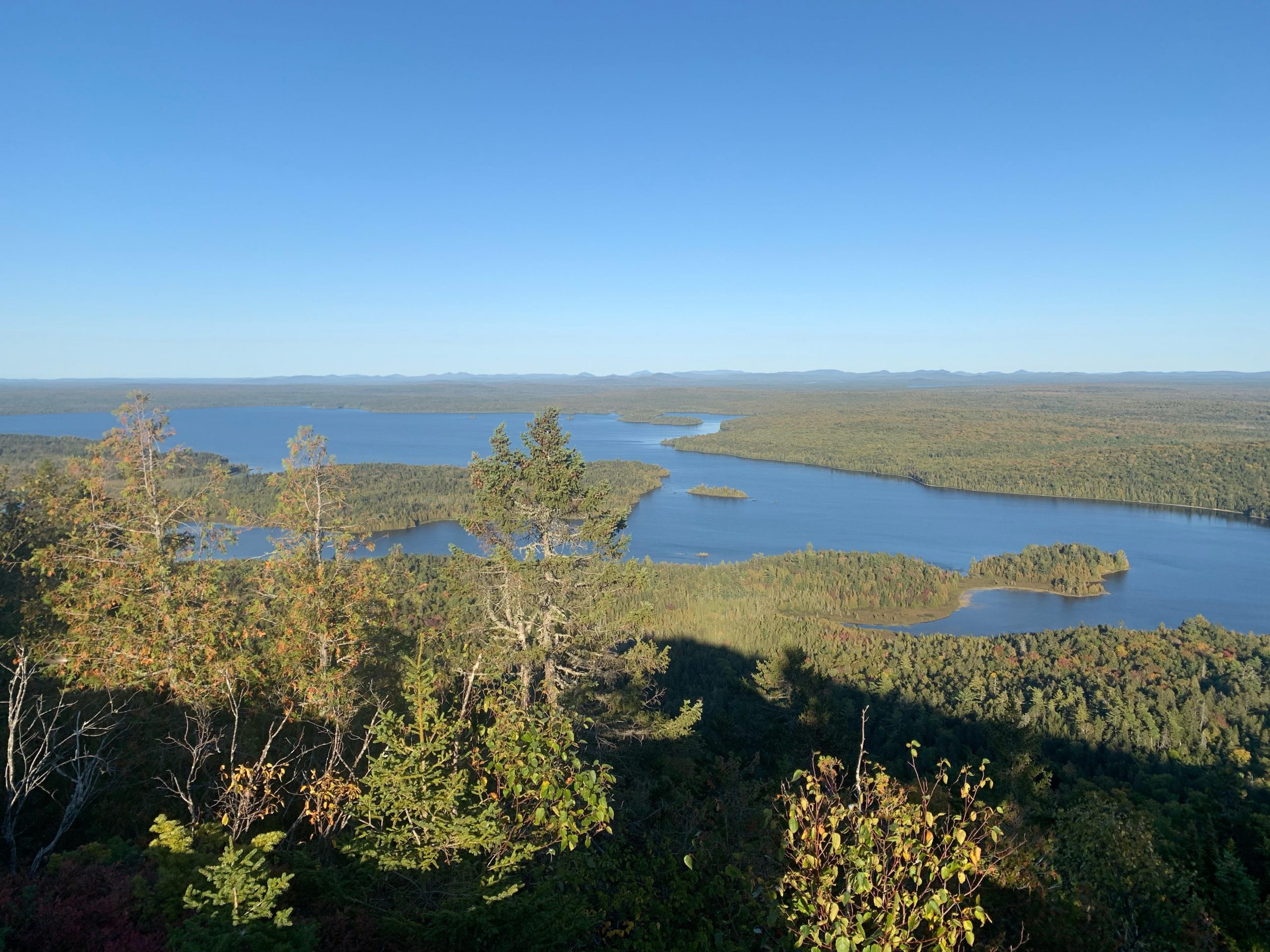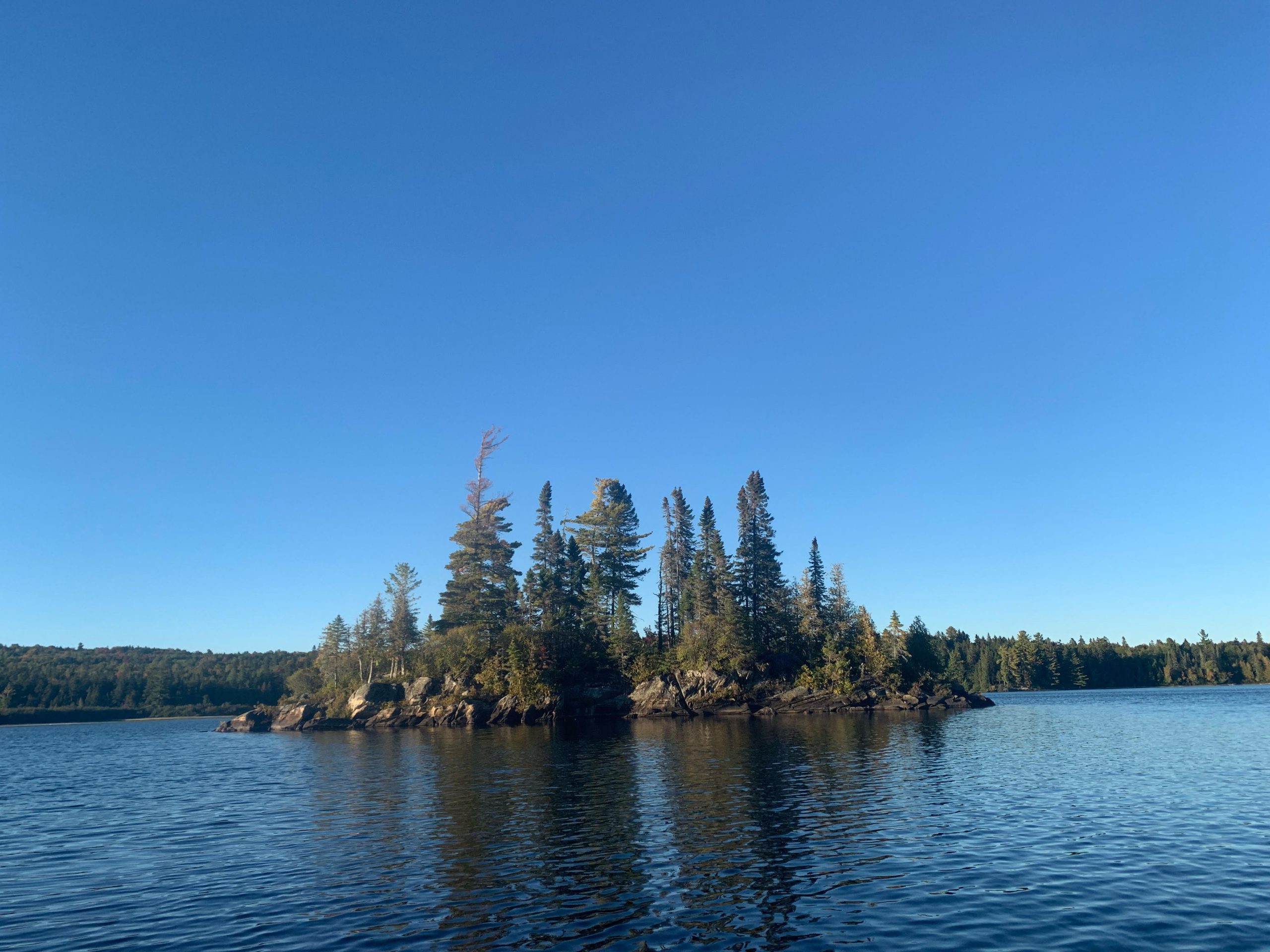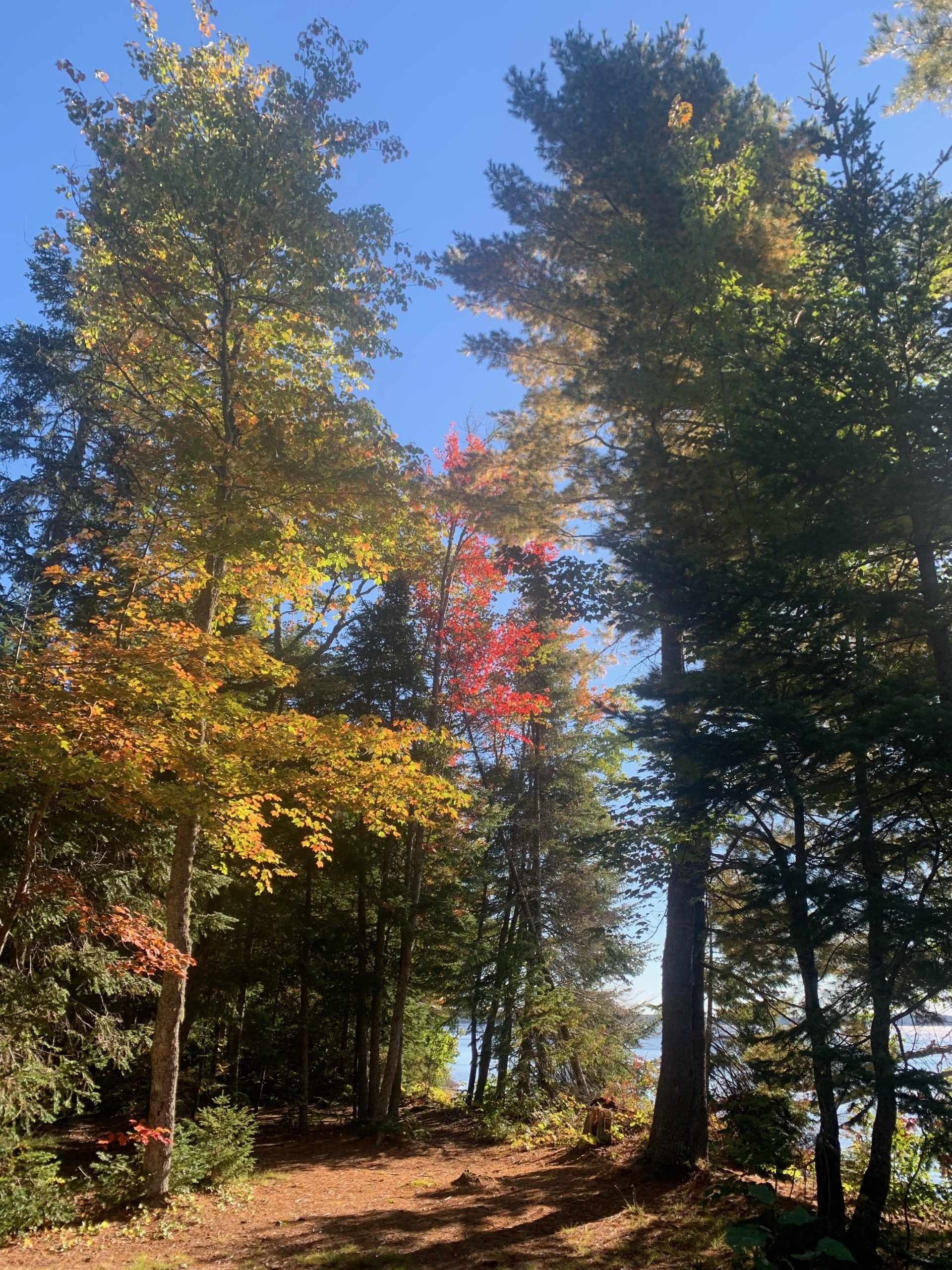
Peak foliage time is here! A time to step out on a trail to your favorite high ground for a long view as Maine mountainsides turn scarlet, orange and gold. Or perhaps your inclination is to find a deep woods path, where you walk close enough to the color display that you can reach out and touch those colors, pick up a leaf from the forest floor and behold it up close in all its intricate beauty? Here is foliage-viewing twist – how about viewing Maine’s annual striking color display from the water? Load up those kayaks and canoes, and take to the water for views that extend up mountain slopes, brighten tiny islands, even – when conditions are right – catch the color display mirrored in the still waters of a deep-woods lake or pond. It is quite the sight!
Franklin County has many fine lakes and ponds for canoeing or kayaking, that offer long views of some of the most striking displays of fall colors to be found anywhere in the world. I will describe a few of my favorite regional vantage points later in this article. To get a head start on the leaf change, I headed to far-northern Maine in the final days of summer, hauling canoes with friends, to distant Allagash Lake, for the better part of a week.

Allagash Lake
Allagash Lake is a pristine 4210’acre lake in northern Piscataquis County, with 24 miles of shoreline, and a maximum depth of 89 feet, lying within the Allagash Wilderness Waterway (AWW). The Waterway is managed by the Maine Burau of Public Lands, following state acquisition of a nearly 100-mile strip of the Allagash River, headwater lakes, and adjoining lands in the 1960’s – a result of the Maine Legislature’s passing of the AWW Statute, and a bond referendum placed before voters who approved it by a 68% to 32% majority. Subsequent financial support came to Maine in accordance with the Wild and Scenic Rivers Act of the US Congress.
The Waterway attracts visitors from across the US and world-wide, bringing economic benefit to the towns in the region such as Greenville, Millinocket, Ashland, and Allagash. Many visitors paddle the full length of the Waterway over a period of 7-10 days, but a network of logging roads in the area make it possible to approach the lakes and rivers at various access points along the way. Such options are popular with local Maine people seeking weekend or other short-term outings. I have made many a trip to the Allagash, canoeing its full length, making circle trips on its headwater lakes, and base camping on a far shore or remote island for day after day of exploring.
Allagash Lake, however, is a set-apart place, even within the already remote Allagash River system, and is less frequently visited than other waters of the AWW. To protect the wild and pristine nature of the water and the surrounding Northern Forest, no motor vehicles are permitted within one mile of the shore of Allagash Lake, and no motor-powered watercraft are allowed. Located nearly 50 miles northwest of Millinocket, and 60 miles north of Greenville, lake access points are reached by travel over logging roads in various stages of repair.
Water access requires navigating inlet streams that are narrow and rocky, or alternately, shallow and muddy – often by dragging the watercraft, sometimes unloading the gear to cut weight. The one road approach ends at a gate one mile from the lake. From here voyageurs must portage their gear and watercraft through the woods to reach the shore. Camping is available in designated sites only. Parties must be equipped to handle emergencies, and must have the paddling experience to manage high winds common on this north-south oriented lake. There is no cell service in this remote region. For well-prepared parties Allagash Lake offers the canoe-camping experience op a lifetime.
It has been my good fortune to have visited Allagash Lake a half-dozen times in recent years.

Fall Arrives in the North Country
Join me as I share sights of fall on Allagash Lake. Two campsites served as home during a recent 6-day visit: Carry Trail Campsite at the southern tip of the lake; and Ice Cave in the northwest corner. Each offers long views of brightening red maple and rock maples in the lake-side forest, and across the slopes of nearby hills. White birch and yellow birch fast turning toward pale yellow. Sumac sport scarlet colors. The oversized leaves of slender moose maples, also known as striped maples, turn to bright gold. These leaves, some a foot or more across, shimmy in the buffeting breezes that blow off the lake.
While hardwoods such as rock maple and red maple, draw foliage-seeker focus, softwoods – pine, spruce, fir, cedar, and hemlock, have their own attractiveness in fall. These confers drop red-brown needles to the forest floor, carpeting the ground. When the low-angle sun of fall touches this ground covering with its rich light, the forest floor glows! One of the most remarkable sights in the Northern Forest is to come across a sunlit softwood glen. We spy many such spots when paddling along the shoreline, past sunlit points, and wooded islands.
One Maine conifer, the larch (also known as hackmatack or tamarack), drops all of its needles in late fall, after those needles have turned a bright orange. It was too early to catch the larch display in the Allagash, but I did see some of these curious trees in the area, still fully green. Larch do grow in Franklin County. Keep your eyes open as October turns towards November, when most of the hardwoods have dropped their leaves, for this one orange needle display.
A benefit to camping for multiple days, and exploring by paddling, is the opportunity to watch colors change day-by-day. As my companions and I made our way, exploring cove after cove, mid-lake islands, and an inlet stream, I noticed daily changes. Paddle by a peninsula one morning, and return the following day to discover yet another red maple was turning scarlet, or that an entire hillside was taking on a golden hue.

Paddling For Foliage in Western Maine
Franklin County and environs offers many a fine paddling opportunity for foliage viewing. In the southern region, Mercer Bog Wildlife Management Area; the northeast cove of Porter Lake; and the inlet of Wilson Stream to Wilson Lake, are among my favorites. Mercer Bog, on Route 2 in Mercer, has a carry-in boat launch for a distance of 100 feet. For Porter and Wilson Lakes, reaching the quieter coves, away from the nearest structure requires a paddling a mile or more each way, but hillside foliage come into view at the launch site – and once in these tucked away coves, I am surrounded by fall color.
In the Northern part of Franklin County (and neighboring counties), some of my favorites are Sandy River Ponds (carry in launch); Rangeley Lakes State Park on Rangeley Lake (drive in launch); Flagstaff Lake launch north of Stratton Village on Highway 27 (drive-in); and Cupsuptic Lake launch on Highway 16 northwest of Oquossoc (drive in). If you are new to paddling, and seek typically quiet waters, Haley Pond adjacent to downtown Rangeley is an option. Rental canoes and kayaks are available in the Rangeley are. Contact the Rangeley Chamber of Commerce for outfitters who rent watercraft.
We are fortunate in Western Maine to have some of the best of the worlds of both hiking and paddling. This year, see the striking Maine foliage from the water! I hope to see you, paddle in hand!
—–

Tips for Fall Paddling
Maine waters are cold in the fall!
Wear your (Personal Flotation Device (PFD). Zip it completely and pull on the straps for a snug fit. PFD’s that are loose may ride up on the body when in the water, and may obstruct vision – or even float away. Children age 10 and younger must wear a PFD at all times when on a watercraft including a kayak, canoe, or stand-up paddleboard.
Sometimes a good role model helps when kids balk at wearing a PFD. Point out to them that the men and women of the Maine Warden Service, some of the most experienced outdoors travelers to be found anywhere, always wear a PFD on the water!
Be prepared to signal – with a whistle or air horn
Standard in my paddling gear are a whistle of good quality, and a small air horn. These go into a pocket of my PFD, where they are easy to reach if I tumble into the water. Even better is to attach a lanyard or cord to the whistle and attach within reach on the PFD. This is particularly important when paddling solo, but truly even when paddling in a group. Righting and emptying a swamped kayak or canoe is very difficult. Prompt assistance is essential. Be prepared with signal devices.
Three blasts on the whistle, or on the air horn – Tweet! Tweet! Tweet! – sounds the international signal for an emergency! Pause for 10 seconds, and repeat.
Keep Together – and Watch the Wind
Keep to a conversation-friendly distance, never allowing a situation in which some watercraft speed ahead, or fall behind. When a mishap occurs on the water quick response is necessary. It is all but impossible to understand paddlers shouting instructions from a distance over water. Establish a lead boat and a trailing boat, with all boaters keeping between these two.
Northwest winds are common on Maine waters, often building to whitecaps in the course of a day that began with morning calm. Consult a weather forecast. On high wind days, seek small, sheltered waters. Go for a hike! Return on another day for that fall foliage paddle.
Get creative with those fallen leaves!
When growing up, our kids enjoyed leaf hunting – finding fallen leaves of many different colors, shapes, and sizes, and turning them into artwork. A kitchen table vase with rock maple leaves is as bright as a bouquet of flowers. Kids love to make collages from fall foliage, and even frame a favorite. I know a local family that celebrated a fall leaf walk by bringing home the broad golden leaf of a moose maple, and placing it in a frame to be hung in the family dining room. The memory of that years-ago childhood walk lives on every time those children, now adults with their own children, pay a visit.





